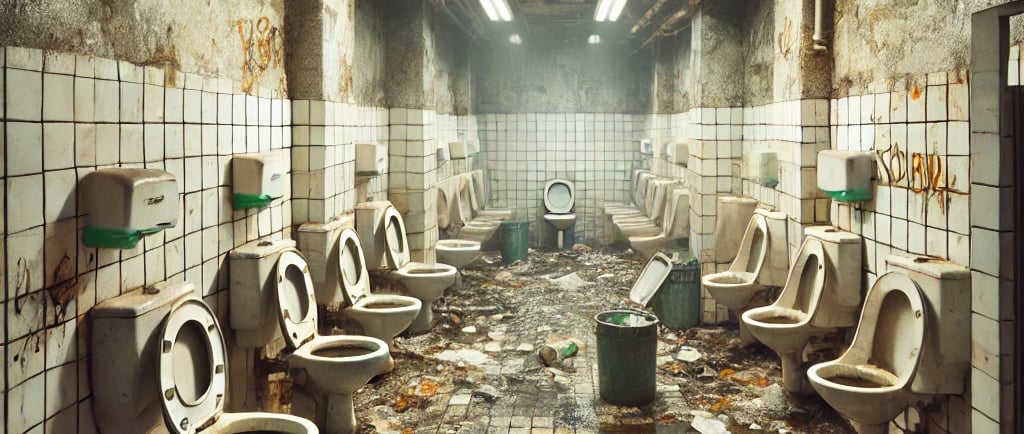The World’s Dirtiest Bathrooms: An Exploration of Hygiene and Cleanliness
12/17/20247 min read


Introduction to Global Bathroom Hygiene
Bathroom hygiene is an essential aspect of public health that significantly influences sanitation and the overall well-being of societies worldwide. The cleanliness of restrooms, whether in private homes or public facilities, plays a fundamental role in preventing the spread of diseases and maintaining health standards. Particularly in densely populated urban areas, the maintenance of hygiene standards in restrooms is paramount, as these spaces can harbor harmful pathogens if not adequately cleaned and managed.
Evaluating bathroom cleanliness involves several criteria, including the presence of visible debris, the smell of the area, the availability of hygiene supplies such as soap and toilet paper, and the general maintenance of fixtures like flush systems and sinks. Public restrooms, in particular, often encounter challenges due to high traffic volumes, making consistent sanitation practices crucial. Ensuring that bathrooms meet cleanliness standards not only fosters a healthier environment but also influences social norms regarding personal care and public facilities.
Across the globe, there are notable differences in bathroom hygiene practices influenced by cultural, economic, and regulatory factors. For instance, certain countries are notorious for having significantly dirtier restrooms compared to their counterparts. These disparities can reflect varying approaches to public health, investment in infrastructure, and societal attitudes toward cleanliness. Countries such as India, Brazil, and parts of Southeast Asia have earned a reputation for notoriously challenging restroom conditions, presenting unique health risks to both locals and travelers.
This exploration of bathroom hygiene will delve into various aspects, including the implications of unclean restrooms, preventative measures, and success stories from nations that have improved their sanitation standards. Understanding bathroom hygiene is paramount not just for individual well-being but for safeguarding society at large against health crises.
Identifying the Dirtiest Countries
Over the years, various studies and surveys have identified several countries that are notorious for having some of the dirtiest bathrooms in the world. These assessments are often based on factors such as cleanliness standards, sanitation practices, water availability, and cultural attitudes toward hygiene. While no country is devoid of unclean facilities, certain regions face more significant challenges in maintaining restroom cleanliness.
One country that consistently ranks poorly in terms of bathroom hygiene is India. Contributing factors include a high population density, inadequate sanitation infrastructure, and a lack of awareness regarding hygiene practices. In many rural areas, open defecation remains a significant challenge, further exacerbating the problems related to cleanliness in public and private restrooms.
Another country frequently mentioned in discussions about unclean bathrooms is Brazil, particularly in urban settings where poverty and inadequate sanitation services can affect restroom conditions. Slum areas often lack proper waste disposal systems, leading to unhygienic public facilities that can impact health and well-being.
African nations, particularly those affected by ongoing conflicts or economic instability, such as the Democratic Republic of the Congo, also face severe sanitation challenges. Limited access to clean water and proper waste management gravely hampers efforts to maintain sanitary restroom facilities.
Additionally, countries in Southeast Asia, such as Indonesia and the Philippines, are often cited for their restroom cleanliness issues. In these regions, cultural perceptions about bathroom maintenance differ significantly, leading to a varied commitment to hygiene practices.
Addressing the problem of dirty bathrooms in these nations requires a multi-faceted approach, including improving infrastructure, promoting hygiene education, and fostering changes in cultural attitudes toward cleanliness. Understanding the root causes of these issues is essential for developing effective solutions.
Cultural Attitudes Towards Bathroom Hygiene
The cultural norms surrounding bathroom hygiene vary significantly across different regions, greatly influencing the state of restrooms around the world. In many western countries, the expectations for cleanliness in bathrooms are high, driven by strong public health campaigns and societal norms that prioritize sanitation. In these societies, public restrooms are typically equipped with basic amenities such as soap, toilet paper, and often hand sanitizers. The emphasis on personal hygiene and cleanliness extends to public facilities, where regular maintenance is usually expected. This high standard of bathroom hygiene reflects a broader cultural attitude that places value on both individual well-being and shared public health.
Conversely, in certain regions, particularly in developing countries, resource constraints and differing cultural attitudes towards sanitation can result in lower standards of bathroom hygiene. In some areas, there may be a strong reliance on traditional methods of sanitation, which can further influence public perceptions of cleanliness. For instance, in parts of South Asia and Africa, the use of open defecation is still prevalent due to historical practices or lack of infrastructure. This has direct implications on public health, as the absence of clean facilities can lead to widespread illness.
Common Factors Contributing to Bathroom Dirtiness
Bathrooms are essential facilities in any setting, yet their cleanliness can vary significantly across regions and countries. A multitude of factors contribute to the state of bathroom hygiene, with inadequate sanitation infrastructure often standing out as a primary issue. In many developing countries, the lack of basic sanitation facilities—such as toilets and running water—creates an environment where bathrooms can become exceptionally dirty. This challenge is frequently exacerbated by insufficient waste disposal systems that fail to handle human waste effectively. Such conditions foster the proliferation of pathogens, leading to severe hygiene concerns.
Another contributing factor is the lack of stringent government regulations and enforcement concerning sanitation standards. In places where such regulations exist, they may not be adequately implemented or monitored, allowing dirty practices to proliferate unchecked. Moreover, this regulatory neglect can often be attributed to broader governance issues, such as corruption or lack of resources, leading to a systemic failure in maintaining public health standards. This situation highlights an urgent need for comprehensive sanitation policies that prioritize cleanliness and hygiene in public spaces.
Poverty also plays a critical role in the cleanliness of bathrooms. In economically disadvantaged areas, access to proper sanitation solutions is often limited. Residents may resort to makeshift toilets or public bathrooms that are rarely cleaned. This creates a cycle of poor hygiene that can impact community health significantly. Additionally, cultural differences surrounding bathroom use and hygiene practices can influence the level of cleanliness. In some cultures, communal bathroom practices may lead to higher levels of filth due to varying standards of personal cleanliness.
Tourism can similarly impact bathroom hygiene. In tourist hotspots, the influx of visitors can overwhelm existing sanitation facilities, leading to potential neglect and poor maintenance. As tourists may not be familiar with local customs, they may also inadvertently contribute to dirtiness. Understanding these various factors is crucial in addressing the challenges of bathroom hygiene on a global scale.
Specific Examples of Dirty Bathroom Conditions
Bathrooms in various regions around the world can manifest distressing levels of uncleanliness, significantly impacting user experience and overall hygiene. A prevalent issue in numerous developing countries is the poor disposal of human waste, which often leads to unsanitary conditions. In some areas, the absence of appropriate waste management infrastructure results in open pits or simply unmonitored heaps of excrement near restroom facilities. Such environments create not only foul odors but also attract a myriad of pests, including flies and rodents, exacerbating the unsanitary situation.
Moreover, it is common to encounter restrooms devoid of essential supplies, such as tissue paper or soap. In rural locations across nations like India or parts of Africa, many public facilities lack basic hygiene necessities, making it impractical for users to maintain personal sanitation. This scarcity of resources contributes to the overall perception of filth associated with these bathrooms. Without proper means to clean oneself after using the toilet, individuals may feel compelled to forgo hygiene practices altogether.
Another major concern is the cleanliness of surfaces within the bathrooms. Public restrooms can frequently be found with grimy floors, stained toilets, and unwashed sinks. The accumulation of dirt and grime often leads to the establishment of unpleasant odors, which can be particularly overwhelming. In many service areas, such as roadside eateries or bus stations in developing countries, the absence of routine cleaning can cause these spaces to present a repellent environment for users.
The issue of pests, including cockroaches and ants, is rampant in many of these unkempt bathrooms. The presence of such creatures not only signifies a lack of cleanliness but also poses health risks to users. Collectively, these specific examples paint a vivid picture of the dire state of bathroom hygiene in various regions, highlighting the urgent need for improvements in restroom facilities worldwide.
Health Implications of Unclean Bathrooms
Unclean bathrooms pose significant health risks, primarily due to the accumulation of pathogens associated with inadequate sanitation. Bathrooms are environments characterized by moisture and warmth, conditions that are conducive for the proliferation of bacteria, viruses, and fungi. The more a bathroom is used without proper cleaning, the higher the likelihood of harmful microorganisms being present, which can lead to serious health concerns. Studies have indicated that areas such as toilet seats, faucets, and floors harbor a variety of germs, including E. coli and norovirus, both notorious for causing gastrointestinal illnesses.
The impact of dirty bathrooms extends beyond individual health, contributing to broader public health issues. For instance, the World Health Organization has emphasized that poor hygiene can facilitate the transmission of infectious diseases, particularly in communal settings like schools and public facilities. The rise of hygiene-related health issues can lead to increased absenteeism in workplaces and schools, ultimately affecting community productivity and well-being.
Moreover, the long-term ramifications of exposure to unsanitary conditions can elevate public health costs. Recent statistics suggest that countries with low sanitation facilities experience higher rates of healthcare expenditures associated with treating diseases linked to poor hygiene practices. For instance, nearly 1.6 million people die annually due to diarrheal diseases, often related to inadequate sanitation. Therefore, ensuring clean bathroom facilities is imperative not only for individual health but also for maintaining community health standards.
In conclusion, the health implications of unclean bathrooms highlight the critical need for effective sanitation practices. Maintaining hygiene in such vital spaces is fundamental for disease prevention, enhancing public safety, and improving the overall quality of life for communities susceptible to the adverse effects of poor sanitary conditions.
Efforts Towards Improvement and Cleanliness Initiatives
Improving bathroom hygiene has become a fundamental challenge in many countries grappling with poor sanitation practices. Various initiatives have emerged globally, spearheaded by governments, non-governmental organizations (NGOs), and community-led groups. These concerted efforts aim to tackle the pressing issue of restroom cleanliness, thereby enhancing overall public health.
Governments play a crucial role in implementing policies designed to improve sanitation infrastructure and hygiene education. Some nations have initiated national campaigns to upgrade public restrooms, focusing on regular maintenance and cleanliness checks. Such government-led programs often include allocating funds for the renovation of existing facilities and building new ones equipped with necessary hygiene features like handwashing stations and adequate drainage systems.
In conjunction with government actions, NGOs have also made significant strides in promoting restroom cleanliness. Organizations dedicated to public health have developed education programs targeting the importance of proper bathroom sanitation. These initiatives are often tailored to local communities, incorporating their unique challenges and cultural contexts into the solutions offered. Furthermore, many NGOs collaborate with local governments to bolster the implementation of sanitation standards, ensuring that restrooms are not only installed but also maintained to meet health regulations.
Community-driven efforts have proven effective in fostering a sense of ownership regarding sanitation practices. Residents often band together to create cleaning schedules for public restrooms, organized maintenance groups, or outreach programs that educate the public on hygiene practices. These grassroots movements have demonstrated success in various regions, showcasing how community engagement can lead to sustainable improvements in bathroom cleanliness.
Thus, the combined efforts of governments, NGOs, and local communities highlight that progress towards cleaner restrooms is achievable. By focusing on education, infrastructure improvement, and community involvement, significant advancements in hygiene can be realized worldwide.
